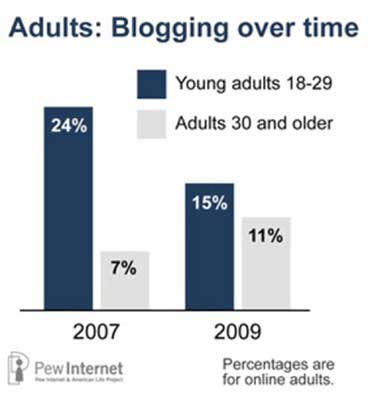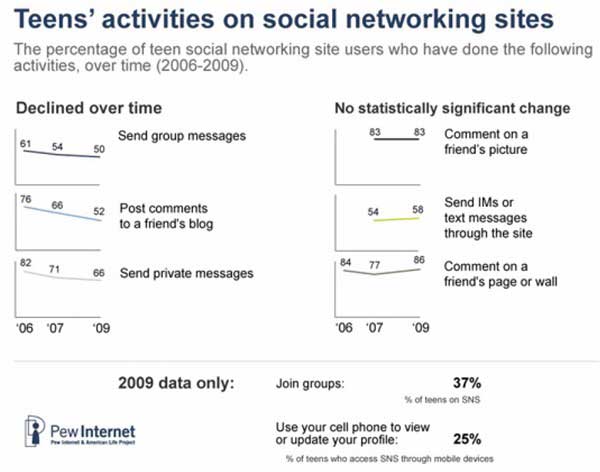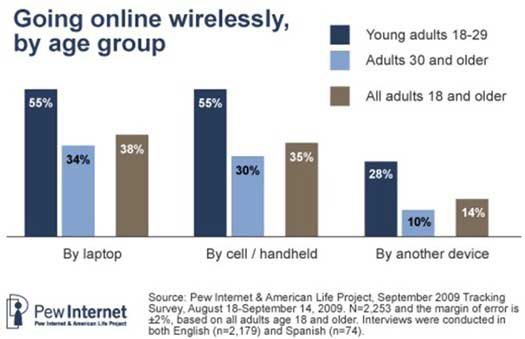Blogging has lost appeal for most teens and young adults in the past three years, but social networks such as Facebook and MySpace are more popular than ever, according to a new report from the Pew Internet & American Life Project.
Although Twitter is popular among young adults, teens are showing little interest, preferring text messaging over tweeting.
Below, highlights from Pew's report, Social Media and Young Adults.
Blogging has declined in popularity among teens (age 12-17) since 2006: 14% of online teens now say they blog, down from 28% who said so in 2006, and 52% of teen users of social networks say they comment on friends' blogs, down from 76% in 2006.
Meanwhile, 15% of online young adults (age 18-29) say they blog, down 9 percentage points from the 24% who said so in 2007.

By comparison, blogging among adults has edged up slightly in recent years: 11% of all online adults say they blog, compared with 7% who said so in 2007.
Social Networking Sites
Teen and adult use of social networking sites has risen significantly in the past three years, but there are shifts and some drops in the proportion of teens using several social networking site features.
Nearly three-quarters (73%) of online teens now use social networking websites, compared with 55% who did so in November 2006, and 65% in February 2008.
As the teen social networking population has increased, the popularity of some sites' features has shifted: 37% of social network-using teens say they send messages to friends every day through social sites, a drop from the 42% who said they did so in February of 2008.
Fewer teens send bulletins, group messages, or private messages to friends from within social network sites.

Among older teens (age 14-17) who use social networking sites:
- 50% say they send group messages, down from 61% who said so in November 2006.
- 66% say they send private messages to friends, down from 82%.
- 52% say they comment on blogs, down from 76%.
Young adults act much like teens in their tendency to use social sites: 72% of online adults age 18-29 use social networking websites, nearly identical to the rate among teens, and significantly higher than the 40% of internet users age 30+ who use these sites.
Meanwhile, adults are increasingly fragmenting their social networking experience: 52% say they have two or more different profiles, up from 42% who had multiple profiles in May 2008.
Facebook is the most commonly used online social network among adults: Among adult profile owners, 73% have a profile on Facebook, 48% have a profile on MySpace, and 14% have a LinkedIn profile.

Nearly two-thirds (66%) of young adults (age 18-29) maintain a profile on MySpace, compared with just 36% among those 30+. Young adults are also less likely to have a profile on LinkedIn (7%) compared with those age 30+.
Looking for real-world examples of businesses achieving their social media marketing goals? Our 47-page case-study collection, Facebook Success Stories, shows you how to increase brand awareness, target specific markets, promote new products, and create communities that engage users. Also check out The State of Social Media Marketing, a 240-page original research report from MarketingProfs.
Twitter and Status Updating Sites
Just 8% of online teens (age 12-17) say they use Twitter. However, older teens are more likely to use Twitter than their younger counterparts: 10% of online teens age 14-17 do so, compared with 5% of those age 12-13.
High-school-age girls are particularly likely to use Twitter: 13% of online girls age 14-17 use Twitter, compared with 7% of boys that age.
Young adults are the most active users of status update services such as Twitter: 33% of Internet users under age 30 say they post or read status updates online.
Meanwhile, over one-third (37%) of the youngest adults (age 18-24) say they post status updates about themselves online or view the updates of others, up from 18% who said so in December 2008.

Wireless Internet
Wireless Internet use is especially high among young adults, and the laptop has replaced the desktop as the computer of choice among those under age 30: 81% of adults age 18-29 access the Internet wirelessly, compared with 63% of those age 30-49, and 34% of those age 50+.
Moreover, 66% of adults under age 30 own a laptop, compared with 52% of those age 30-49, and 40% of those age 50-64.
Overall, the computer remains the most popular way for teens to go online: 93% of teens use a desktop or laptop computer to access the Internet, followed by a cell phone (27%), game console––e.g., PS3, Xbox, and Wii––(24%), or portable gaming device (19%).
Over half (55%) of young adults age 18-29 say they access the Internet wirelessly on a laptop or on a cell phone, and 28% say they use other devices, such as an e-book reader or gaming device.

Other findings:
- 75% of teens (age 12-17), and 93% of young adults (age 18-29) now have a cell phone.
- 66% of teens send and receive text messages.
- 58% of 12-year-olds own a cell phone, up from just 18% of such teens as recently as 2004.
- 62% of online teens get news about current events and politics online.
- 48% of wired teens have made an online purchase––including such items as books, clothing, or music––up from 31% who had done so in 2000.
- 31% of online teens get health, dieting, or physical fitness information from the Internet.
- 17% of online teens report they use the Internet to gather information about health issues that are difficult to discuss with others, including topic such as drug use and sexual health topics.
About the data: The report Social Media and Young Adults is published by the Pew Internet & American Life Project, part of a series by the Pew Research Center that highlights the attitudes and behaviors of the Millennial generation. The most current data on teens is drawn from a survey conducted from June 26 to Sept. 24, 2009 of 800 US adolescents (age 12-17). The adult data are drawn from a survey conducted from August 18 to Sept. 14, 2009 of 2,253 US adults (age 18 +).



